From the Times via CDT an article about a group of Chinese intellectuals who are asking for some new people to be put on Chinese currency. This is actually a big issue, since who nations put on their money is a political statement of some importance.1 The list of suggested people is pretty interesting. They are suggesting Qu Yuan, Li Bai, Yue Fei, and Wen Tianxiang. The Times calls Qu Yuan a poet, which he was, but of course he was much better known as a protester against political corruption. Li Bai is the “pure” poet in the group, and Yue Fei and Wen Tianxiang are both straight nationalist figures who died resisting foreign interference in China’s internal affairs. It is a well-thought out list (Not all Mao, but nationalistic enough to pass muster) and I wish them luck, but I suspect not much will change. Chinese money has always been very focused on politicians.
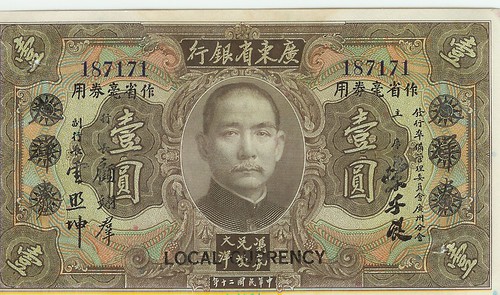
Sun Yat-sen got most of the face time under the Republic, appearing on all sorts of notes.
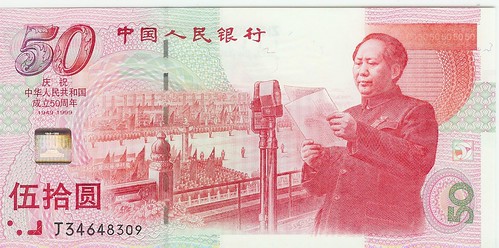
Mao has taken pride of place since.
Below is a 1945 note with Lin Sen, President of the Republic and one of the very few non-ultimate leader politicians to make it on the money
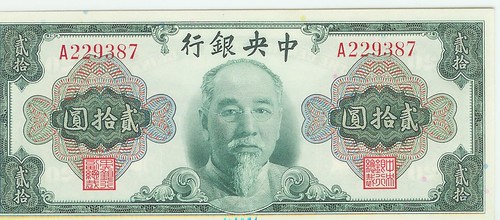
A lot of nations will put great heroes of the past on the currency, in part to avoid the whole cult of personality thing. China has not done this much. Below is a Commercial Bank of China note with (I assume) Confucius on it. After May 4th a lot of the great culture heroes were “Feudal” and did not work well as symbols of the new nation

Apparently nobody told the Japanese that, as they liked putting Confucius on the money
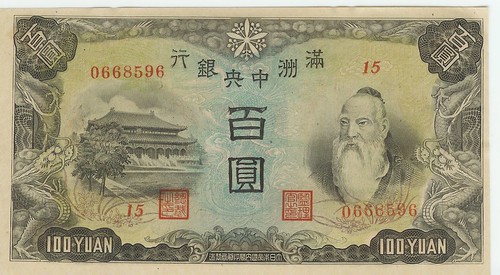
One of the puppet governments in North China issued notes with Confucius, the symbol of Chinese culture and Prince Shotoku, symbol of Japanese culture. Supposedly in one of the early versions a Chinese engraver made Confucius flick Prince Shotoku an obscene gesture. Not sure if that story is true, but I hope it is.
To the extent you do get symbols of Traditional China on Chinese money they tend to be abstract and cleaned up by a connection to nationalism, like the note below, with a traditional ritual vessel and Sun Yat-sen
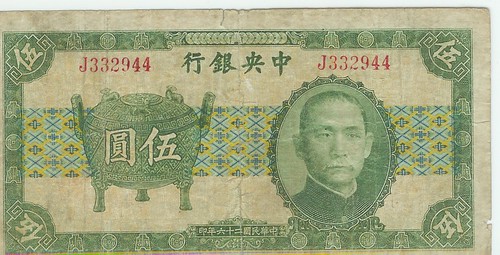
Like many other nations China has tried to symbolize the national past with common people, like the Farmer’s Bank note below.
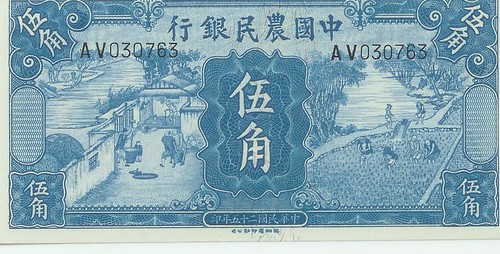
Below is one from Xinjiang which shows both farming (the canonical occupation for men) and weaving (the canonical occupation for women) Given that Xinjiang was not a very Han place under the Republic they may have been trying to emphasize their Chinese-ness
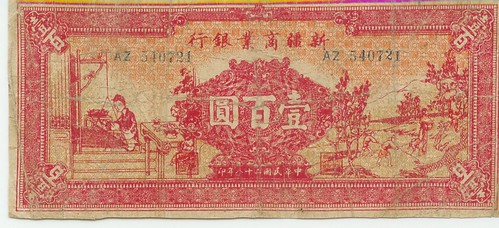
Foreign banks could tie themselves to China too, as with the Sino-Scandinavian Bank note below, which emphasizes the great historic links between China and Scandinavia. Frankly I’m not sure if in the 1920’s pictures that bring to mind white people coming from across the sea to rob you was the best selling point for a Chinese audience. The bank folded in 1927

Regional banks could of course do national symbols, but a lot of them seem to have done scenic spots to play up local identity, such as the Guangxi note below
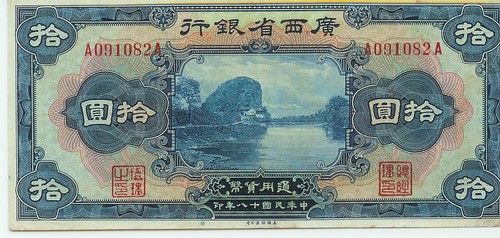
Or this Anhui note, which gives the impression that Anhui does not have much for scenery.
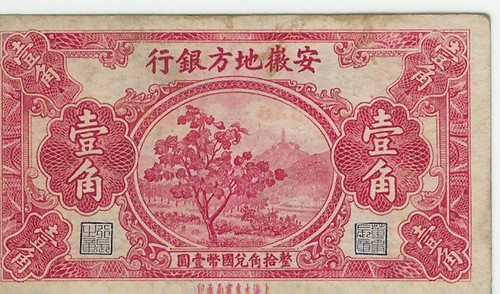
The big theme that comes out if you look at a lot of Chinese money however is modernization. Lots of pictures of how we are making China into a developed country.
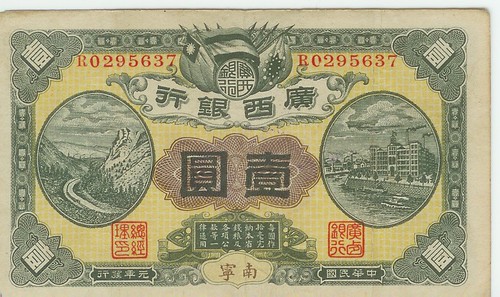
Provincial banks did it, like the Guanxi note above with a road and a building (this is a 1912 note, and they seem to be blurring their political position by putting in all three revolutionary flags) Below is a Guangdong note with yet another modern building.
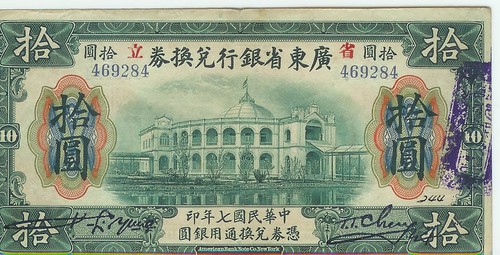
Many of these seem pretty unimpressive today. So China has trains, big deal
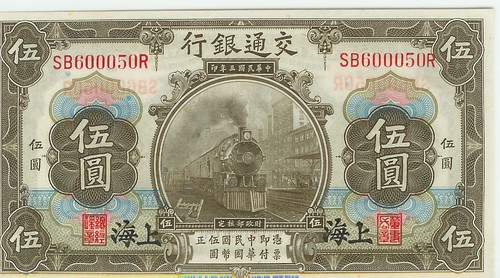
Or they seem to emphasize bits of modernization that one might not celebrate, as with this circulating bond to build a new (modern) prison.

The Communists at first did some fairly radical stuff, as below
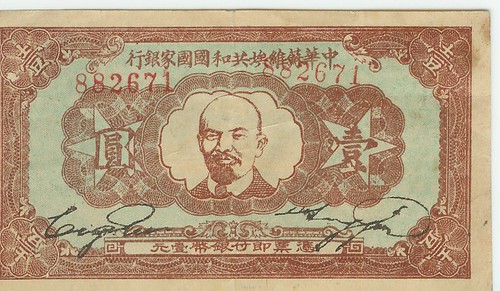
But they pretty soon settled down into doing fairly standard development stuff. (a lot of their pre-1949 notes were actually very traditional and could just as well have been from any provincial bank)
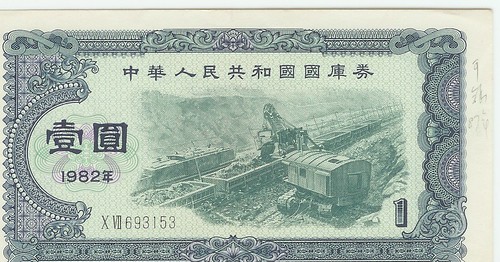
But as below, it was Communist development, with the all-important tractor and of course a woman driving it.

The note above has People’s Bank of China written in lots of minority languages. Minorities get a lot of play since 1976

But it is mostly all Mao all the time. The real issue of course will not be who to put on if we take Mao off some of the notes, it will be will anyone have the nerve to take him off at all.
I’ve always thought that American money had remained stuck in the 19th century because of a lack of national confidence. If someone did suggest changing our money some Democrat would probably suggest putting MLK on there and Republicans would go nuts about political correctness. Easier to stick with Jackson. Plus, if we went with more modern designs and colors like most of the world has done in might turn us gay. ↩
Alan: cease and desist! If you keep up this stream of postings which are so educational and easy to read , then our students will think that they don’t have to pay those outrageous tuitions to take our classes and just read this blog!
Did that 50th Anniversary 50-yuan note with Mao on the rostrum ever circulate? It’s much more attractive than the 5th series version.
Zhwj,
I think it was just a special issue. I know I never saw one. Plus it makes Mao look way too human for day to day use.
Thanks for the educational review. I grew up using currencies post 1976. Of course you can buy alot of stuff with 10 Yuan back then. I would say in the 70s with 10 Yuan you can go on a shopping spree. Now I think you need 1000 Yuan to do the same.
I’ve got one to add to the collection: http://china.notspecial.org/archives/2008/06/xinjiang_1941.html
“To the extent you do get symbols of Traditional China on Chinese money they tend to be abstract and cleaned up by a connection to nationalism”
One fairly consistent ‘traditional’ symbol- even going into the Communist notes- are the images of metal coins in the corners. I stole that observation from Beth Nolar (“Viewing Currency ‘Chaos’: Paper Money for Advertising, Ideology and Resistance in Republican China.” In Terry Bodenhorn, ed. Defining Modernity: Guomindang Rhetorics of a New China, 1920-1970. Ann Arbor: University of Michigan Press, 2002, 123-149), who sees it as a way of making sure that paper money is taken seriously as money- particularly when different currencies, often by political and military rivals, were circulating.
Speaking of countries that like to use currencies for political propaganda, did you know they are coming up with a new penny? There are two choices of “scenes from Lincoln’s life.” Just a completely random thought also to add: I find it interesting that in China, anything over 1 yuan has a picture of Mao on it (the smaller bills representing money less than a dollar have minorities or peasants on them). In America, however, our greatest “heroes” are on our smaller bills; George Washington on the 1 dollar bill is much more important to our country’s national spirit and identity than Hamilton (at least that was what I was taught in school…)